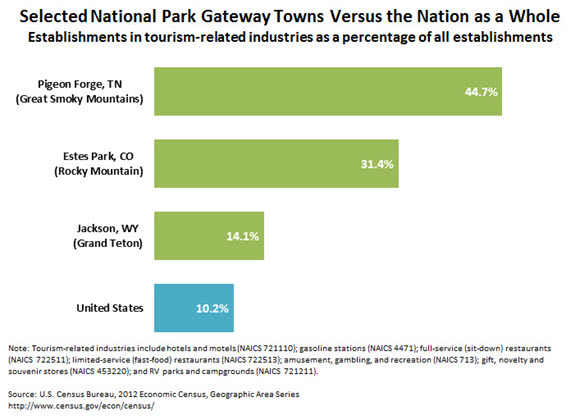"National Parks and the Economy of Their ""Gateway Towns"""
"National Parks and the Economy of Their ""Gateway Towns"""
Nowhere is our nation’s natural beauty on more vivid display than in its more than 400 national parks. Maintained by the National Park Service for exactly one century this summer, these venues have long been popular destinations for summer vacations and weekend getaways.
The term “National Park” immediately conjures up images of some of their most famous landmarks, such as “Old Faithful” in Yellowstone, “Half Dome” in Yosemite and the waves crashing into the rocky shores of Acadia, but national parks also include places where American history was written and that preserve the unique culture of our nation. For many visitors, their first stops are the “gateway communities” that serve national parks. Located not far from the parks’ entrances, these towns are critical to tourists for lodging, food and “gassing up.”
Tourism related industries including hotels (except casino hotels) and motels; full-service (sit-down) restaurants; limited-service (fast food) restaurants; gasoline stations; amusement, gambling, and recreation; gift, novelty, and souvenir stores; and RV parks and campgrounds accounted for more than 10 percent of all U.S. establishments and employed 12.4 million people in 2012. In honor of the National Park Service’s centennial, we’re taking a closer look at three gateway communities surrounding the national parks, including which industries are most prevalent, by examining data from the Census Bureau’s 2012 Economic Census.
Pigeon Forge, Tennessee
Pigeon Forge, Tenn., located a few miles from the Great Smoky Mountains National Park (the nation’s most visited park, according to the National Park Service [PDF <1.0 MB]), provides an example of the importance of these industries to these towns. Sales there totaled:
- $135.2 million for hotels and motels (NAICS 721110).
- $27.2 million for gasoline stations (NAICS 4471).
- $90.5 million for full-service (sit-down) restaurants (NAICS 722511) and $26.4 million for limited-service (fast food) restaurants (NAICS 722513).
Sales for these four industries combined topped $279.0 million. Three of these industries are in the accommodations and food services sector and account for 84.9 percent ($252.1 million) of the sector’s total revenues of $296.9 million. The only other sectors in town with revenues anywhere close are retail trade (which includes gasoline stations) at $241.1 million, and arts, entertainment and recreation, at $230.7 million. The latter sector includes another tourism-related subsector: amusement, gambling, and recreation (NAICS 713). If you throw in its revenues of $154.1 million; $27.0 million from gift, novelty and souvenir stores (NAICS 453220); and $5.7 million generated by RV parks and campgrounds (NAICS 721211), tourism-related sales and revenues exceeded $466.0 million in Pigeon Forge.
The town of 5,984 people (according to 2012 population estimates) contained 84 hotels and motels and 41 full-service restaurants, or one hotel and motel for every 71 residents and one full-service restaurant for every 146 people. These seven tourist-related industries combined account for 44.7 percent of the town’s business establishments and employ 5,999 people (higher than the population, including children).
Estes Park, Colorado
Moving west, Estes Park, Colo., is just outside Rocky Mountain National Park, the fifth most visited park according to the National Park Service [PDF <1.0 MB]. Sales there totaled:
- $45.1 million for hotels and motels,
- $21.7 million for full-service (sit-down) restaurants and $8.3 million for limited-service (fast food) restaurants, and
- $11.1 million for gasoline stations
Combined, these four industries totaled $86.2 million in sales/revenues. Three of these industries are in the accommodations and food service sector and account for 81.5 percent ($75.1 million) of the sector’s total of $92.2 million. Only the retail trade sector, which includes gasoline stations, had higher sales/revenues among sectors.
This town of 6,027 people (according to 2012 population estimates) was home to 39 hotels and motels and 38 full-service restaurants, or roughly one each for every 150 residents. The four industries — hotels and motels, sit-down restaurants, fast-food restaurants and gas stations — employed 1,059 people. If you add gift, novelty, and souvenir stores, they accounted for over one-quarter (127 or 30.2 percent) of the town’s business establishments.
Jackson, Wyoming
Our final stop takes us to Jackson, Wyo., five miles from the Grand Teton National Park, the nation’s eighth most visited park according to the National Park Service, where sales for hotels and motels, full-service restaurants, gasoline stations and limited-service restaurants totaled:
- $82.0 million for hotels and motels,
- $55.0 million for full-service (sit down) restaurants and $18.0 million for limited-service (fast food) restaurants, and
- $51.5 million for gasoline stations
These industries totaled more than $206.0 million combined. This exceeded revenues for each of the following sectors: health care and social assistance ($154.1 million); professional, scientific and technical services ($104.7 million); real estate and rental and leasing ($73.4 million); wholesale trade ($43.1 million); and manufacturing ($20.8 million).
As you observe the natural beauty of our country’s parks this summer, consider the economic census statistics that give us insight into the communities surrounding them.
Happy 100th birthday, National Park Service!






